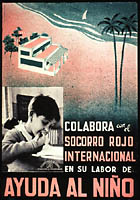 |
Colabora con el Socorro Rojo Internacional en su labor de ayuda al niño
[Collaborate with International Red Aid and its effort to help children]. Signed: Padial. Socorro Rojo de España. Lit: S. Dura. Socializado U.G.T. C.N.T. Valencia Lithograph, three colors and halftone, black and white; 40 x 27 cm.
|
|
Very little is known
of the artist Padial. It is clear, however, that he was capable
of combining photography with drawing and painting for Socorro Rojo
Internacional's propaganda. In the photograph, a little girl peacefully
enjoys a meal, presumably at one of International Red Aid's Children's
Homes. In the background, a modern-looking villa overlooks a tranquil
ocean setting; the sleek modernity of the villa suggests International
Red Aid could safeguard children in places more suitable than the
dilapidated cities. A rhythmic use of black, white, light red, and
teal results in a serene and peaceful image. The poster appeals
for financial support for these services that the International
Red Aid offered children. The poster was released in Valencia through
S. Dura, a lithography firm jointly collectivized by the CNT and
the UGT, probably in late 1936 or early 1937, when many of the union
chapters put aside their differences to coordinate their collectives.
International Red Aid
originated in the Soviet Union in 1925. The organization was designed
to provide assistance to political prisoners and their families
throughout the world. It first made its appearance in Spain after
the workers' rebellion of October 1934. With the financial support
of the Comintern and private donations, International Red Aid became
one of the largest and most recognizable charity organizations of
the Spanish Civil War: it transformed various buildings throughout
the Republican zone into hospitals or clinics, organized a transportation
network that facilitated getting medicine and provisions to soldiers
at the fronts, and transported casualties from the battle fronts
to its vast hospital network. International Red Aid also covertly
aided communist sympathizers trapped in the Nationalist zone make
their escape to the Republican zone.
|




